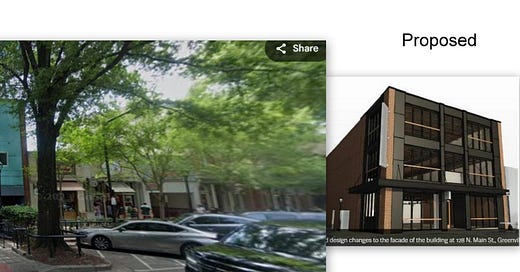Renovating an Ugly Duckling in Greenville
The Greenville town center on Main Street is currently, at long last, seeing the renovation of a long-standing eyesore building.
The turquoise building on the left has been a hideous eyesore on Main Street for decades. On the right is what a shameful modernist firm has proposed now that an agreement involving city money being made available for a “new and improved” façade has been completed.
The only good thing I can see out of this coming renovation – this tragically missed opportunity -- is that a lot of people will react by saying, “we waited for decades to improve that building façade, and this is the ‘improvement’?????? We, as citizens, demand that the City stop wasting tax dollars to give us ugly duckling modernism and instead use buildings that fit in. Buildings using a style we like!”
In other words, we can hope that this will give modernist building design an enduring black eye in Greenville. A black eye that motivates citizens to say “NO!” to proposed new modernist buildings for many decades, and hopefully forever.
Including a long-needed revision to local land development regulations that prohibit modernism by city code – especially when city tax dollars are used. And especially for new government buildings.
It really bothers me that city tax dollars are being spent so that the ugliest building will now be slightly less ugly. Even a three-year-old could do better than this. Even a child would be smart enough to suggest making the new building façade match the façade style of the nearby buildings.
I guess such a suggestion is a form of incomprehensible rocket science, which is apparently what happens when, as a modernist, you drink the Kool-Aid via an “advanced” degree in architecture (a failed profession as of the 1930s).
Shame on modernist architects for deciding, arrogantly, that innovation is better than having a building fit in with its neighbor buildings – particularly when those neighbor buildings are using timeless design (i.e., design that has been loved for many generations).





